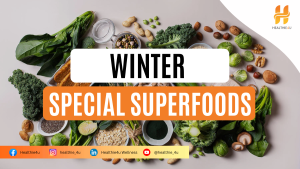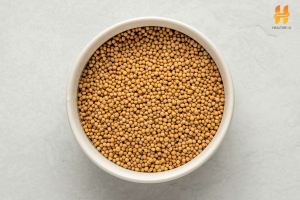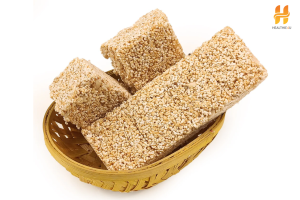

Winter in India offers a rich variety of superfoods that not only nourish the body but also help keep you warm, enhance immunity, and sustain energy during the cold months.
Although specific winter foods have a powerful effect, it’s your overall eating habits that truly count. A diet rich in essential nutrients can help manage seasonal challenges such as joint discomfort, weight gain, constipation, dry skin, and hair loss, while supporting immunity, healthy skin, and overall wellness. Here’s a look at some foods that qualify as Winter Superfoods.
1. Mustard-

Mustard oil is a go-to for winter skincare, as it nourishes dry, cracked skin with its abundance of fatty acids and Vitamin E. Additionally, mustard seeds improve blood circulation, helping counteract the sluggish blood flow that often occurs in the cold.
2. Jaggery-

Jaggery is known for its warming properties, boosting body heat and aiding digestion while preventing bloating. Rich in antioxidants and minerals, it helps clear airways, reduce mucus, and strengthen immunity during the winter months.
3. Cinnamon-

Cinnamon warms you up in winter and strengthens your immune system to fight off seasonal illnesses. It also improves circulation and soothes sore throats and coughs, especially when mixed with honey or ginger.
4. Sonth-

Sonth (dry ginger powder) is a powerful winter remedy that generates warmth, boosts digestion, and relieves bloating and constipation. It boosts the immune system, helping to prevent seasonal illnesses, and works as an effective remedy for coughs and congestion. Its anti-inflammatory properties also relieve joint and muscle pain.
5. Rajgira-

Rajgira is rich in iron, calcium, magnesium, and vitamins, making it a great energy booster during the winter months. Its high protein content supports muscle health, while its calcium helps strengthen bones and reduce joint stiffness caused by the cold.
6. Bajra-

Bajra is full of complex carbs, giving you long-lasting energy to stay active and warm all day. It also has important minerals like zinc, magnesium, and iron, which help boost your immune system. The magnesium in bajra helps your heart by improving blood flow and lowering blood pressure, which is especially helpful in winter when cold weather can slow circulation.
7. Pink guava-

Pink guava is a delicious and nutritious fruit, packed with antioxidants that boost immunity, especially in winter when our defenses are weaker. Rich in vitamin C, it helps strengthen the immune system and promotes glowing skin. It also clears mucus and phlegm, supporting healthy lungs and respiratory function.
8. Saffron-

Saffron is known for its warm, pleasant aroma and bright color, which makes it a popular ingredient in winter recipes and remedies. It’s rich in antioxidants, helps boost your mood, supports digestion, and helps keep your skin healthy and glowing.
9. Til-

Sesame seeds (til) are an excellent food for winter, providing a range of health benefits. They help strengthen the immune system, protecting you from seasonal illnesses. With their warming properties, they improve blood circulation, which is especially important during the colder months when circulation can slow. Til is also known to support bone health thanks to its high calcium content.
10. Carrot-

Carrots are a great winter food, packed with beta-carotene, which helps keep your skin healthy and prevents dryness in colder weather. The vitamin A in carrots also supports good vision. Their natural sweetness makes them an ideal addition to warming soups and stews. Plus, carrots help maintain a healthy glow, even when the cold air can leave skin looking dull and dry.
11. Peas-

Peas are a great food to eat in winter. They are full of vitamin C, which helps strengthen your immune system and fight off colds. Peas also have fiber, which helps keep your digestion healthy and can prevent constipation during the winter months. They are also a good source of vitamin K, which is important for strong bones, and folate, which helps keep your energy levels up.
12. Amla-

Packed with Vitamin C and antioxidants, amla strengthens immunity. It helps keep the skin hydrated and glowing, preventing dryness, while also strengthening hair and reducing hair fall due to its high iron content.
13. Barley-

As a slow-digesting carb, barley provides steady energy throughout the day, combating winter fatigue. Its high fibre content helps lower cholesterol and protect cardiovascular health, which is important during winter when heart disease risk increases. Rich in antioxidants and selenium, barley also promotes skin health and aids in natural detoxification.
14. Ajwain-

Ajwain is widely recognized for its digestive benefits, as it aids in stimulating digestion and easing winter-related issues like bloating and gas from heavier meals. Its natural warming properties help maintain body heat, making it perfect for the colder months. It also helps clear blocked airways when consumed in warm drinks or steam. Additionally, with its anti-inflammatory properties, ajwain is effective in reducing joint pain and stiffness that often occur during the winter season.
15. Sweet potatoes-

Sweet potatoes are a winter powerhouse, providing long-lasting energy with their complex carbohydrates. They help provide warmth, comfort, and essential nutrients to support both your physical health and overall well-being. Rich in vitamin A (beta-carotene) and vitamin C, it protects skin and boosts immunity. It also contains vitamin B6 which helps improve mood and energy, making them perfect for the colder months.
Adding these winter superfoods to your diet can help you stay warm, energised, and healthy throughout the colder months. They boost immunity, improve circulation, and help fight common cold-weather illnesses like dry skin and joint discomfort. Enjoy these nutrient-dense foods to nourish your body and enhance your well-being this winter.
















